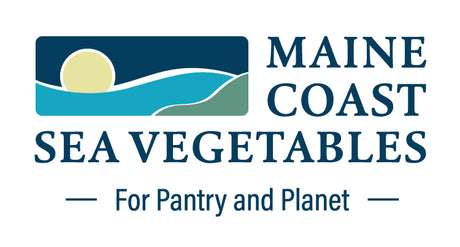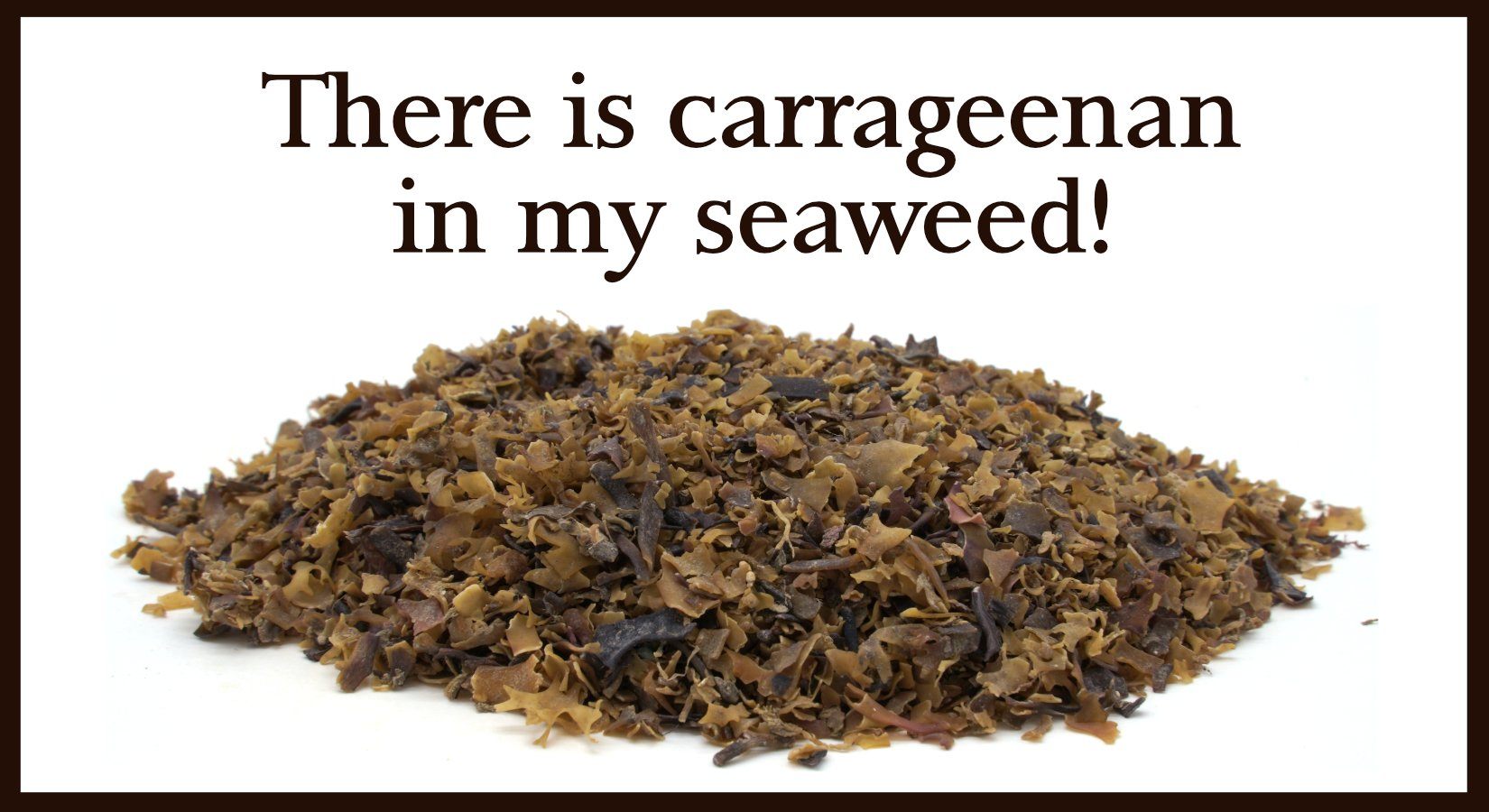Lots of folks eat seaweed daily without knowing it, or at least a form of it. This is because carrageenan extracted from seaweed is an ingredient in so many processed foods. Carrageenan is now hard to avoid but questions have been raised about its safety, which causes concern for some seaweed lovers. If carrageenan isn’t safe in processed foods, does that mean the carrageenan found naturally in seaweed is also unsafe? The short answer is no, but read on to learn more.
What is carrageenan?
Carrageenan is a generic name for a group of seaweed polysaccharides widely used in food and cosmetics for their gel-forming qualities as thickeners, emulsifiers, and stabilizers. Many modern foods we take for granted were made possible or improved by carrageenan, including soy milk, chocolate milk, low-fat ice cream, and infant formulas. Although it may seem as though carrageenan is a modern invention cooked up in the lab for industrial food production, it’s actually been used for many centuries by home cooks and healers.


Irish moss (Chondrus crispus)
Carrageenan was originally extracted from Irish moss Chondrus crispus. In 1819, Dawson Turner observed in his four-volume work, British Fuci, that Irish moss would melt in boiling water and then harden into a gelatin as the mixture cooled. It’s believed the name “carrageen” was first applied to this substance in 1829 from the Irish word carraigín, translated as “little rock”; probably because Irish moss grows abundantly along the shores of Carrigan Head near Northern Ireland. Irish moss had been eaten by the Irish since the Middle Ages, and throughout the 1800’s they used carrageen in recipes and also as a remedy for respiratory and other ailments.
During the potato famine of the mid-1800’s Irish moss was a source of nourishment, and immigrants helped spread it to the new world, including Jamaica, where it’s said to increase male libido and virility. This power may be best epitomized in a popular Jamaican Irish moss drink sold under the “Big Bamboo” logo.
Irish moss and carrageenan became globally prominent during World War II, when Japanese supplies of agar-agar (another seaweed thickener) were disrupted. Up to that point agar was the world’s major non-animal gelling ingredient (gelatin, another widely used gelling agent, is derived from bones). Similar to carrageenan, agar-agar is a polysaccharide extracted from red seaweeds (primarily Gracilaria), but with a different molecular structure and gelling properties.
A major Irish moss harvesting and processing industry developed in New England and the Maritime Provinces of Canada during and after the war, and today carrageenan remains the leading seaweed extract on the worlds’ markets. If you’re ever in Scituate Massachusetts, be sure to visit the Maritime and Mossing Museum, where you can learn about Scituate’s Irish moss kings.

Kappaphycus farm - Seaweed aquaculture for carrageenan doesn't require chemical or fertilizer inputs, and it removes carbon dioxide from the ocean.
Irish moss no longer reigns as the world’s major carrageenan source, and alas, gone are the days of Scituate’s Irish moss kings. Most carrageenan now comes from farmed tropical seaweeds, primarily Eucheuma and Kappaphycus. The Philippines is a major hub for this farming activity, where it has brought economic benefits to over 200,000 coastal families and lifted many from poverty. A variety of wild-harvested seaweeds, including Irish moss, may be blended with farmed species to form products with desired emulsifying characteristics.
So what’s the problem?
Carrageenan’s versatility has made it a seemingly universal food ingredient, but success hasn’t come without controversy. The controversy is sometimes attributed to Dr. Joann Tobacman of the University of Illinois at Chicago, who published the first of her several research papers on carrageenan in 1997. Perhaps the most influential was this 2001 review article highlighting studies showing carrageenan could cause inflammation and was possibly even carcinogenic. Although earlier studies had also found cause for concern, Tobacman’s publications seemed to light a fire, and before long the Cornucopia Institute became perhaps the most prolific and vocal anti-carrageenan voice on (and off) the internet.
In reading Cornucopia writings on the topic (such as this publication), one is struck by the certainty of their convictions. Indeed, many have been, and there are now seemingly thousands of internet articles warning about the dangers of carrageenan. Unfortunately, it’s often been the case that cautious speculation in one article becomes full blown fact in another. Thus, it’s declared by some that carrageenan causes cancer, when in fact numerous studies show it does not.
The FDA continues to list carrageenan as a safe food additive and the USDA allows it to be included in certified organic foods. In Europe, carrageenan is hardly an issue at all, and EFSA, (European Food Safety Authority) recently concluded in this report that carrageenan derived from Eucheuma seaweed was safe. The Food and Agriculture Organization issued a joint report with the World Health Organization that said carrageenan could be used in infant formulas at up to 1 g per liter. Carrageenan is also approved by the Japan Ministry of Health, the Brazilian Health Surveillance Agency, Health Canada, Food Standards Australia/New Zealand, the China Ministry of Health, and others. In every case, carrageenan’s safety was first established by experts after a thorough review of the science.
Are the world’s major food safety authorities misinformed, or even worse, being manipulated by the agricultural industrial complex? Is carrageenan truly as dangerous as some say? The truth, as is often the case in the world of science, is nuanced. Many of the studies used as evidence of carrageenan’s danger have been justifiably criticized for their methods, assumptions, and conclusions. In many cases these studies tested a completely different substance known as poligeenan, which can be ‘degraded’ from carrageenan under extreme conditions of high heat and acidity.
Poligeenan differs molecularly from carrageenan, is not useful as a stabilizer, and it isn’t approved for food. However, some researchers believe carrageenan could become degraded to poligeenan in the gut (studies show this is unlikely), or that it may be accidentally present with carrageenan in foods (studies are contradictory). Perhaps the biggest flaw with these studies is that poligeenan (and in some cases carrageenan) was fed to animals at unrealistically high levels and in isolation from other food ingredients (i.e. added to drinking water). Another criticism of carrageenan is that it causes inflammation when it’s injected into the paws of rodents.
This reaction is frequently used in inflammation studies to evaluate the inflammatory potential of various substances, and carrageenan opponents often cite these studies. However, leaving aside the fact that all sorts of things provoke inflammation when injected under the skin, researchers have had difficulty showing the same response occurs in the gut when carrageenan is ingested, probably because as a dietary fiber it isn’t digested or absorbed.
Studies like these are examples of nutritional reductionism, described in our bromine post as a narrow focus on a single substance in isolation from the complex whole food in which it’s normally found. It’s tempting to ignore evidence that contradicts one’s argument; something we try to avoid in this blog. As a sulfated polysaccharide, carrageenan in seaweed may share some of the same bioactive and therapeutic attributes seen with other seaweed sulfated polysaccharides (discussed in this study or this one showing carrageenan is a powerful inhibitor of the human papillomavirus known as HPV). Perhaps those Irish healers of the 1800’s deserve more credit. Carrageenan opponents rarely mention these studies, and if they do it’s only to quickly dismiss them.
Context and content are important when considering the biological activity of any food substance, and the real culprit may be that our modern diet consists of too many highly processed foods and not enough whole foods. With that in mind, enjoy your Irish moss and all the other sea vegetables. Whether eaten as whole leaf or milled into granules or powder, all of our sea vegetables are minimally processed, unheated whole foods, containing no additives or artificial ingredients. Good for you, and good for the planet too.



